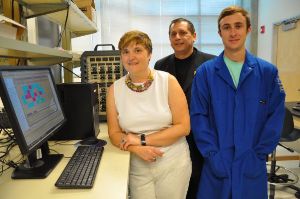May 19 2014
Researchers at the University of California, Riverside have developed a novel nanometer scale ruthenium oxide anchored nanocarbon graphene foam architecture that improves the performance of supercapacitors, a development that could mean faster acceleration in electric vehicles and longer battery life in portable electronics.
 From left, Mihrimah Ozkan, Cengiz Ozkan and Zachary Favors in the Ozkan's lab.
From left, Mihrimah Ozkan, Cengiz Ozkan and Zachary Favors in the Ozkan's lab.
The researchers found that supercapacitors, an energy storage device like batteries and fuel cells, based on transition metal oxide modified nanocarbon graphene foam electrode could work safely in aqueous electrolyte and deliver two times more energy and power compared to supercapacitors commercially available today.
The foam electrode was successfully cycled over 8,000 times with no fading in performance. The findings were outlined in a recently published paper, “Hydrous Ruthenium Oxide Nanoparticles Anchored to Graphene and Carbon Nanotube Hybrid Foam for Supercapacitors,” in the journal Nature Scientific Reports.
The paper was written by graduate student Wei Wang; Cengiz S. Ozkan, a mechanical engineering professor at UC Riverside’s Bourns College of Engineering; Mihrimah Ozkan, an electrical engineering professor; Francisco Zaera, a chemistry professor; Ilkeun Lee, a researcher in Zaera’s lab; and other graduate students Shirui Guo, Kazi Ahmed and Zachary Favors.
Supercapacitors (also known as ultracapacitors) have garnered substantial attention in recent years because of their ultra-high charge and discharge rate, excellent stability, long cycle life and very high power density.
These characteristics are desirable for many applications including electric vehicles and portable electronics. However, supercapacitors may only serve as standalone power sources in systems that require power delivery for less than 10 seconds because of their relatively low specific energy.
A team led by Cengiz S. Ozkan and Mihri Ozkan at UC Riverside are working to develop and commercialize nanostructured materials for high energy density supercapacitors.
High capacitance, or the ability to store an electrical charge, is critical to achieve higher energy density. Meanwhile, to achieve a higher power density it is critical to have a large electrochemically accessible surface area, high electrical conductivity, short ion diffusion pathways and excellent interfacial integrity. Nanostructured active materials provide a mean to these ends.
“Besides high energy and power density, the designed graphene foam electrode system also demonstrates a facile and scalable binder-free technique for preparing high energy supercapacitor electrodes,” Wang said. “These promising properties mean that this design could be ideal for future energy storage applications.”